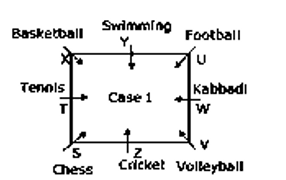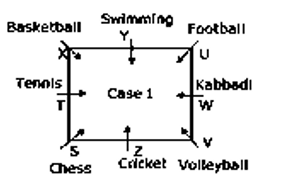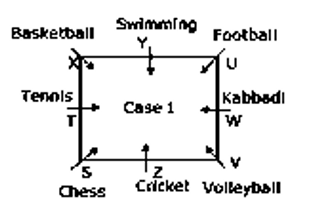Question 1: 
Question 2: 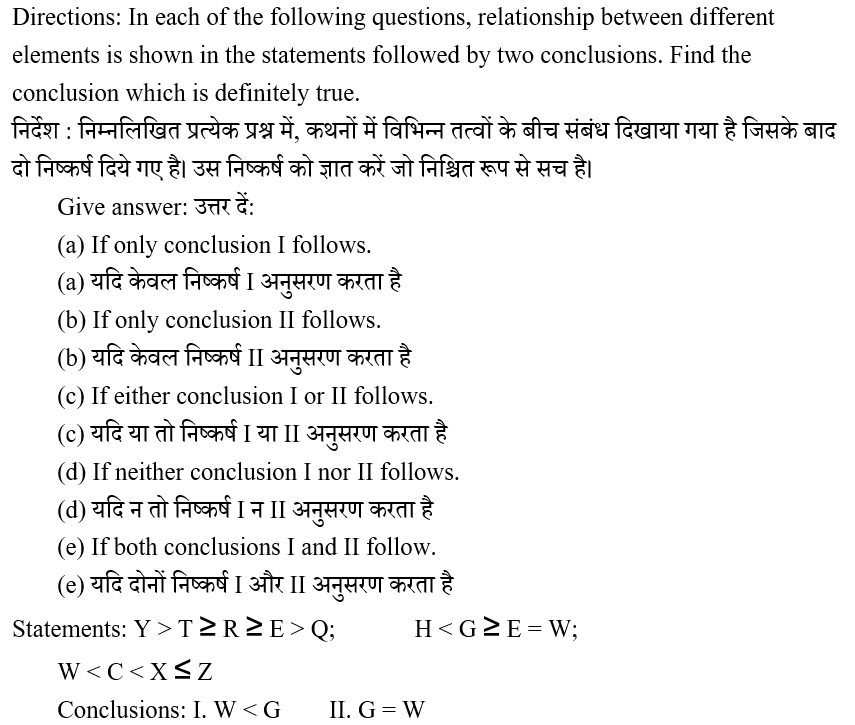
Question 3: 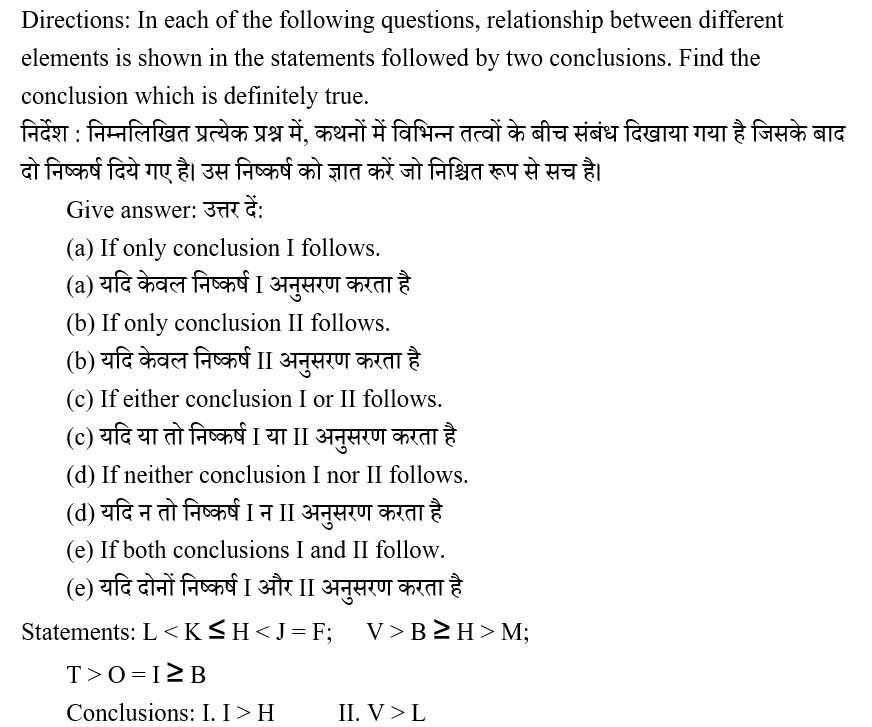
Question 4: 
Question 5: 
Question 6:
Direction : Study the following information carefully and answer the questions given below.
निर्देश : निम्नलिखित जानकारी का ध्यानपूर्वक अध्ययन करें और नीचे दिए गए प्रश्नों का उत्तर दें।
Eight persons S, T, U, V, W, X, Y, and Z are sitting around a square table and all of them are facing center of the table. Each of them like different sports viz., Chess, Cricket, Volleyball, Basketball, Swimming, Football, Kabaddi, and Tennis but not necessary in the same order. Four of them are sitting in middle of the four sides and four of them are sitting in four corners of the table.
S is an immediate neighbor of the one who likes Tennis and the one who likes Cricket. U sits third to the right of Z. The one who likes Volleyball and the one who likes Basketball is sitting diagonally opposite to each other. There are two persons sitting between S and Y. S is an immediate neighbor of Z. W is not an immediate neighbor of both T and X. X sits fourth to the left of V. U does not like Chess. X does not like Tennis and Volleyball. S does not sit in the middle of the sides. W does not like Cricket and Tennis. The one who likes Swimming and the one who likes Basketball are immediate neighbors. Z sits second to the left of W, who likes Kabaddi. U does not like Basketball. T does not like cricket.
आठ व्यक्ति S, T, U, V, W, X, Y, और Z एक वर्गाकार टेबल के गिर्द बैठे हैं और उनमें से सभी टेबल के केंद्र की ओर मुख किए हैं। उनमें से प्रत्येक अलग-अलग खेल जैसे शतरंज, क्रिकेट, वॉलीबॉल, बास्केट बॉल, तैराकी, फुटबॉल, कबड्डी और टेनिस पसंद करते है लेकिन जरूरी नहीं उसी क्रम में। उनमें से चार, टेबल के चार सिरों के बीच में बैठे हैं और उनमें से चार टेबल के चार कोनों में बैठे हैं।
S, टेनिस पसंद करने वाले व्यक्ति और क्रिकेट पसंद करने वाले व्यक्ति का निकटतम पड़ोसी है। U, Z के दाईं ओर तीसरे स्थान पर बैठता है। वह जो वॉलीबॉल पसंद करता है और जो बास्केटबॉल पसंद करता है वह एक-दूसरे के विपरीत तिरछे बैठे हैं। S और Y के बीच दो व्यक्ति बैठे हैं। S, Z का निकटतम पड़ोसी है। W, T और X दोनों का निकटतम पड़ोसी नहीं है। X, V के बाईं ओर चौथे स्थान पर बैठता है। U शतरंज पसंद नहीं करता है। X, टेनिस और वॉलीबॉल पसंद नहीं करता है। S, सिरों के बीच में नहीं बैठता है। W, क्रिकेट और टेनिस पसंद नहीं करता है। जो तैराकी पसंद करता है और जो बास्केट बॉल पसंद करता है वे निकटतम पड़ोसी हैं। Z, W के बाईं ओर दूसरे स्थान पर बैठता है, जो कबड्डी पसंद करता है। U, बास्केटबॉल पसंद नहीं करता है। T, क्रिकेट पसंद नहीं करता है।
Which sports like the one who sits second to the right of X?
X के दाईं ओर दूसरे स्थान पर बैठने वाला व्यक्ति कौन सा खेल पसंद करता है?
Question 7:
Direction : Study the following information carefully and answer the questions given below.
निर्देश : निम्नलिखित जानकारी का ध्यानपूर्वक अध्ययन करें और नीचे दिए गए प्रश्नों का उत्तर दें।
Eight persons S, T, U, V, W, X, Y, and Z are sitting around a square table and all of them are facing center of the table. Each of them like different sports viz., Chess, Cricket, Volleyball, Basketball, Swimming, Football, Kabaddi, and Tennis but not necessary in the same order. Four of them are sitting in middle of the four sides and four of them are sitting in four corners of the table.
S is an immediate neighbor of the one who likes Tennis and the one who likes Cricket. U sits third to the right of Z. The one who likes Volleyball and the one who likes Basketball is sitting diagonally opposite to each other. There are two persons sitting between S and Y. S is an immediate neighbor of Z. W is not an immediate neighbor of both T and X. X sits fourth to the left of V. U does not like Chess. X does not like Tennis and Volleyball. S does not sit in the middle of the sides. W does not like Cricket and Tennis. The one who likes Swimming and the one who likes Basketball are immediate neighbors. Z sits second to the left of W, who likes Kabaddi. U does not like Basketball. T does not like cricket.
आठ व्यक्ति S, T, U, V, W, X, Y, और Z एक वर्गाकार टेबल के गिर्द बैठे हैं और उनमें से सभी टेबल के केंद्र की ओर मुख किए हैं। उनमें से प्रत्येक अलग-अलग खेल जैसे शतरंज, क्रिकेट, वॉलीबॉल, बास्केट बॉल, तैराकी, फुटबॉल, कबड्डी और टेनिस पसंद करते है लेकिन जरूरी नहीं उसी क्रम में। उनमें से चार, टेबल के चार सिरों के बीच में बैठे हैं और उनमें से चार टेबल के चार कोनों में बैठे हैं।
S, टेनिस पसंद करने वाले व्यक्ति और क्रिकेट पसंद करने वाले व्यक्ति का निकटतम पड़ोसी है। U, Z के दाईं ओर तीसरे स्थान पर बैठता है। वह जो वॉलीबॉल पसंद करता है और जो बास्केटबॉल पसंद करता है वह एक-दूसरे के विपरीत तिरछे बैठे हैं। S और Y के बीच दो व्यक्ति बैठे हैं। S, Z का निकटतम पड़ोसी है। W, T और X दोनों का निकटतम पड़ोसी नहीं है। X, V के बाईं ओर चौथे स्थान पर बैठता है। U शतरंज पसंद नहीं करता है। X, टेनिस और वॉलीबॉल पसंद नहीं करता है। S, सिरों के बीच में नहीं बैठता है। W, क्रिकेट और टेनिस पसंद नहीं करता है। जो तैराकी पसंद करता है और जो बास्केट बॉल पसंद करता है वे निकटतम पड़ोसी हैं। Z, W के बाईं ओर दूसरे स्थान पर बैठता है, जो कबड्डी पसंद करता है। U, बास्केटबॉल पसंद नहीं करता है। T, क्रिकेट पसंद नहीं करता है।
What is the position of T with respect to V?
V के संबंध में T की स्थिति क्या है?
Question 8:
Direction : Study the following information carefully and answer the questions given below.
निर्देश : निम्नलिखित जानकारी का ध्यानपूर्वक अध्ययन करें और नीचे दिए गए प्रश्नों का उत्तर दें।
Eight persons S, T, U, V, W, X, Y, and Z are sitting around a square table and all of them are facing center of the table. Each of them like different sports viz., Chess, Cricket, Volleyball, Basketball, Swimming, Football, Kabaddi, and Tennis but not necessary in the same order. Four of them are sitting in middle of the four sides and four of them are sitting in four corners of the table.
S is an immediate neighbor of the one who likes Tennis and the one who likes Cricket. U sits third to the right of Z. The one who likes Volleyball and the one who likes Basketball is sitting diagonally opposite to each other. There are two persons sitting between S and Y. S is an immediate neighbor of Z. W is not an immediate neighbor of both T and X. X sits fourth to the left of V. U does not like Chess. X does not like Tennis and Volleyball. S does not sit in the middle of the sides. W does not like Cricket and Tennis. The one who likes Swimming and the one who likes Basketball are immediate neighbors. Z sits second to the left of W, who likes Kabaddi. U does not like Basketball. T does not like cricket.
आठ व्यक्ति S, T, U, V, W, X, Y, और Z एक वर्गाकार टेबल के गिर्द बैठे हैं और उनमें से सभी टेबल के केंद्र की ओर मुख किए हैं। उनमें से प्रत्येक अलग-अलग खेल जैसे शतरंज, क्रिकेट, वॉलीबॉल, बास्केट बॉल, तैराकी, फुटबॉल, कबड्डी और टेनिस पसंद करते है लेकिन जरूरी नहीं उसी क्रम में। उनमें से चार, टेबल के चार सिरों के बीच में बैठे हैं और उनमें से चार टेबल के चार कोनों में बैठे हैं।
S, टेनिस पसंद करने वाले व्यक्ति और क्रिकेट पसंद करने वाले व्यक्ति का निकटतम पड़ोसी है। U, Z के दाईं ओर तीसरे स्थान पर बैठता है। वह जो वॉलीबॉल पसंद करता है और जो बास्केटबॉल पसंद करता है वह एक-दूसरे के विपरीत तिरछे बैठे हैं। S और Y के बीच दो व्यक्ति बैठे हैं। S, Z का निकटतम पड़ोसी है। W, T और X दोनों का निकटतम पड़ोसी नहीं है। X, V के बाईं ओर चौथे स्थान पर बैठता है। U शतरंज पसंद नहीं करता है। X, टेनिस और वॉलीबॉल पसंद नहीं करता है। S, सिरों के बीच में नहीं बैठता है। W, क्रिकेट और टेनिस पसंद नहीं करता है। जो तैराकी पसंद करता है और जो बास्केट बॉल पसंद करता है वे निकटतम पड़ोसी हैं। Z, W के बाईं ओर दूसरे स्थान पर बैठता है, जो कबड्डी पसंद करता है। U, बास्केटबॉल पसंद नहीं करता है। T, क्रिकेट पसंद नहीं करता है।
Four of the following five are alike in a certain way based on the given seating arrangement and thus form a group. Which one does not belong to that group?
निम्नलिखित पांच में से चार एक निश्चित तरीके से दिए गए बैठने की व्यवस्था के आधार पर एक जैसे हैं और इस प्रकार एक समूह बनाते हैं। कौन सा उस समूह से संबंधित नहीं है?
Question 9:
Direction : Study the following information carefully and answer the questions given below.
निर्देश : निम्नलिखित जानकारी का ध्यानपूर्वक अध्ययन करें और नीचे दिए गए प्रश्नों का उत्तर दें।
Eight persons S, T, U, V, W, X, Y, and Z are sitting around a square table and all of them are facing center of the table. Each of them like different sports viz., Chess, Cricket, Volleyball, Basketball, Swimming, Football, Kabaddi, and Tennis but not necessary in the same order. Four of them are sitting in middle of the four sides and four of them are sitting in four corners of the table.
S is an immediate neighbor of the one who likes Tennis and the one who likes Cricket. U sits third to the right of Z. The one who likes Volleyball and the one who likes Basketball is sitting diagonally opposite to each other. There are two persons sitting between S and Y. S is an immediate neighbor of Z. W is not an immediate neighbor of both T and X. X sits fourth to the left of V. U does not like Chess. X does not like Tennis and Volleyball. S does not sit in the middle of the sides. W does not like Cricket and Tennis. The one who likes Swimming and the one who likes Basketball are immediate neighbors. Z sits second to the left of W, who likes Kabaddi. U does not like Basketball. T does not like cricket.
आठ व्यक्ति S, T, U, V, W, X, Y, और Z एक वर्गाकार टेबल के गिर्द बैठे हैं और उनमें से सभी टेबल के केंद्र की ओर मुख किए हैं। उनमें से प्रत्येक अलग-अलग खेल जैसे शतरंज, क्रिकेट, वॉलीबॉल, बास्केट बॉल, तैराकी, फुटबॉल, कबड्डी और टेनिस पसंद करते है लेकिन जरूरी नहीं उसी क्रम में। उनमें से चार, टेबल के चार सिरों के बीच में बैठे हैं और उनमें से चार टेबल के चार कोनों में बैठे हैं।
S, टेनिस पसंद करने वाले व्यक्ति और क्रिकेट पसंद करने वाले व्यक्ति का निकटतम पड़ोसी है। U, Z के दाईं ओर तीसरे स्थान पर बैठता है। वह जो वॉलीबॉल पसंद करता है और जो बास्केटबॉल पसंद करता है वह एक-दूसरे के विपरीत तिरछे बैठे हैं। S और Y के बीच दो व्यक्ति बैठे हैं। S, Z का निकटतम पड़ोसी है। W, T और X दोनों का निकटतम पड़ोसी नहीं है। X, V के बाईं ओर चौथे स्थान पर बैठता है। U शतरंज पसंद नहीं करता है। X, टेनिस और वॉलीबॉल पसंद नहीं करता है। S, सिरों के बीच में नहीं बैठता है। W, क्रिकेट और टेनिस पसंद नहीं करता है। जो तैराकी पसंद करता है और जो बास्केट बॉल पसंद करता है वे निकटतम पड़ोसी हैं। Z, W के बाईं ओर दूसरे स्थान पर बैठता है, जो कबड्डी पसंद करता है। U, बास्केटबॉल पसंद नहीं करता है। T, क्रिकेट पसंद नहीं करता है।
How many persons sitting between U and the one who likes basketball, if we count anti clockwise direction from U?
U और बास्केटबॉल पसंद करने वाले व्यक्ति के बीच कितने व्यक्ति बैठे हैं, अगर हम U से घड़ी की विपरित दिशा में गिनते हैं?
Question 10:
Direction : Study the following information carefully and answer the questions given below.
निर्देश : निम्नलिखित जानकारी का ध्यानपूर्वक अध्ययन करें और नीचे दिए गए प्रश्नों का उत्तर दें।
Eight persons S, T, U, V, W, X, Y, and Z are sitting around a square table and all of them are facing center of the table. Each of them like different sports viz., Chess, Cricket, Volleyball, Basketball, Swimming, Football, Kabaddi, and Tennis but not necessary in the same order. Four of them are sitting in middle of the four sides and four of them are sitting in four corners of the table.
S is an immediate neighbor of the one who likes Tennis and the one who likes Cricket. U sits third to the right of Z. The one who likes Volleyball and the one who likes Basketball is sitting diagonally opposite to each other. There are two persons sitting between S and Y. S is an immediate neighbor of Z. W is not an immediate neighbor of both T and X. X sits fourth to the left of V. U does not like Chess. X does not like Tennis and Volleyball. S does not sit in the middle of the sides. W does not like Cricket and Tennis. The one who likes Swimming and the one who likes Basketball are immediate neighbors. Z sits second to the left of W, who likes Kabaddi. U does not like Basketball. T does not like cricket.
आठ व्यक्ति S, T, U, V, W, X, Y, और Z एक वर्गाकार टेबल के गिर्द बैठे हैं और उनमें से सभी टेबल के केंद्र की ओर मुख किए हैं। उनमें से प्रत्येक अलग-अलग खेल जैसे शतरंज, क्रिकेट, वॉलीबॉल, बास्केट बॉल, तैराकी, फुटबॉल, कबड्डी और टेनिस पसंद करते है लेकिन जरूरी नहीं उसी क्रम में। उनमें से चार, टेबल के चार सिरों के बीच में बैठे हैं और उनमें से चार टेबल के चार कोनों में बैठे हैं।
S, टेनिस पसंद करने वाले व्यक्ति और क्रिकेट पसंद करने वाले व्यक्ति का निकटतम पड़ोसी है। U, Z के दाईं ओर तीसरे स्थान पर बैठता है। वह जो वॉलीबॉल पसंद करता है और जो बास्केटबॉल पसंद करता है वह एक-दूसरे के विपरीत तिरछे बैठे हैं। S और Y के बीच दो व्यक्ति बैठे हैं। S, Z का निकटतम पड़ोसी है। W, T और X दोनों का निकटतम पड़ोसी नहीं है। X, V के बाईं ओर चौथे स्थान पर बैठता है। U शतरंज पसंद नहीं करता है। X, टेनिस और वॉलीबॉल पसंद नहीं करता है। S, सिरों के बीच में नहीं बैठता है। W, क्रिकेट और टेनिस पसंद नहीं करता है। जो तैराकी पसंद करता है और जो बास्केट बॉल पसंद करता है वे निकटतम पड़ोसी हैं। Z, W के बाईं ओर दूसरे स्थान पर बैठता है, जो कबड्डी पसंद करता है। U, बास्केटबॉल पसंद नहीं करता है। T, क्रिकेट पसंद नहीं करता है।
Who sits third to the right of V?
V के दाईं ओर तीसरे स्थान पर कौन बैठता है?


